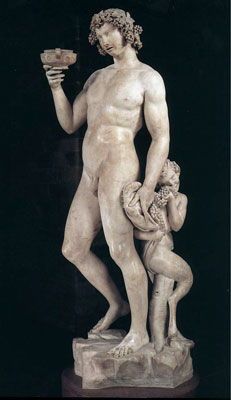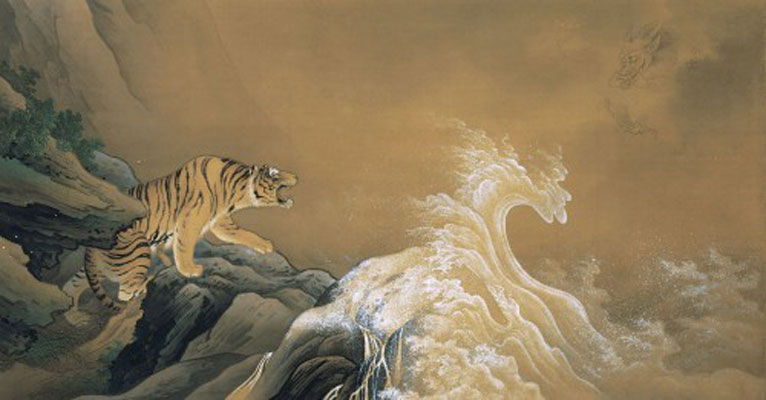
Apollo and Daphne, Bernini courtesy of Borghese Gallery
Background
This sculpture was created by Gian Lorenzo Bernini and finished in 1625 as a commission from Cardinal Scipione Borghese. The sculpture itself depicts the story of Apollo and Daphne from Ovid's Metamorphoses, in this story Apollo was shot by Cupid's arrow and pursues Daphne who rejects him. Despite this Apollo continues his pursuit until Daphne prays to her father, a river god, who turns her into a laurel tree. When you get close-up views of the piece you can see her hands and hair transforming into branches, and parts of her skin turning into tree bark.

Bacchus, Michelangelo 1497 courtesy of The Art Story
Looking at Bacchus which was sculpted by Michelangelo, you can see the difference in styles immediately. In this piece despite Bacchus being drunk, he is still in a stable stance and both feet touching the ground. There aren't any dramatic curves through the sculpture as in Baroque art, and I find it harder to read his expression as anything but blank.
While Michelangelo is indeed a master, you can see the difference in the drama and emotions expressed in the different eras of art. Renaissance art focused on beauty and perfection, while Baroque focuses more on the tension and emotions the piece are supposed to convey. The best way I think of it is that Renaissance art focuses more on the after or even during an event, while Baroque is the moments leading up to the event or just as the event is happening.
The Council of Trent's Influence
The Council of Trent were three sessions that took place between 1545 and 1563, this was the Catholic Church trying to come up with ways to counteract the Protestant Reformation. They wanted all works of art, from paintings to songs, to be easier for an everyday person to understand which was very different from the Mannerist approach. They also wished for art to hold morals and values within them. Bernini agreed with the Council of Trent that art should be easily understood and invoke emotions in the viewer, which can be seen in his works.
Members of the church are were among his commissioners during this period, such as Cardinal Scipione Borghese, and even Pope Urban VIII. Along the bottom of Apollo and Daphne, there is an inscription in Latin "Those who love to pursue fleeing forms of pleasure, In the end find only leaves and bitter berries in their hands", which was a poem by Pope Urban VIII. This inscription gives this sculpture that is based on mythology, a moral that is taught in the churches.
My Thoughts
This is one of my favorite pieces by Bernini, the emotions and movement he was able to capture within the sculpture are amazing. Not only that but how he was able to capture this in-between moment as Daphne is starting her transformation is what I love about it. I hope to one day see it in person to really appreciate the details and look at it from multiple angles. Theoretically, I would own this piece or a replica, but realistically I wouldn't have the space for it.
I really enjoy more of the art within the Baroque period than the Renaissance, I find the style more appealing and how emotional and dramatic the pieces are.
Sources
“Apollo and Daphne by Bernini.” Galerie Borghèse, 2 Aug. 2019, borghese.gallery/collection/sculpture/apollo-and-daphne.html.
“Apollo and Daphne.” Artble, 19 July 2017, www.artble.com/artists/gian_lorenzo_bernini/sculpture/apollo_and_daphne.
Cooper, James F. “Bernini.” Newington-Cropsey Cultural Studies Center, 2008, www.nccsc.net/essays/bernini.
“Medici: Godfathers of the Renaissance . Renaissance . Counter Reformation.” PBS, Public Broadcasting Service, www.pbs.org/empires/medici/renaissance/counter.html.

Hi Jada! This is the second Bernini sculpture I've been introduced to via student art blogs here and I'm already a huge fan. The way he captured such dramatic moments was ingenious.
ReplyDeleteI find it interesting that sculptures like this survived the Council of Trent's scrutiny. From what I understand, they were strictly against pagan iconography and nudity in religious works, but it seems like it was a-okay in purely pagan depictions like this one.
From what I could find, since it was commissioned from higher ups in the church it was a-okay. That and the little poem inscribed at the base to give it a moral to learn from, it passed their scrutiny.
DeleteBernini was also favored by Pope Urban VIII and he commissioned architecture from him, but he passed before anything could be built and the new pope, Pope Innocent X, wasn't a fan of his and nothing was ever built. So I think having that favoritism on his side probably also helped.
I almost did my blog post on this one! I found its novelty, compared to prior planning and presentation of sculptures really awesome. I believe this was one purposefully created and placed as a centerpiece so as to experience it from several angles, not just a one point of view. For that reason I loved the activity it invites or demands.
ReplyDeleteFrom my research, this sculpture was actually originally against a wall and so the best view of it is supposed to be from the side. It was later moved to the center of the room, which I think was good decision since you get to see from every angle.
DeleteI did the same artwork. I really enjoyed this one. I referenced the influence of power in mine, considering a lot of wealthy people wanted to own it because of the constant motion and how it represents power and wealth. I love how the artist was able to capture the motion of not only Daphne changing, but Apollo’s shock and feelings as well. I would love to own a picture or something of this sculpture with the story below it, so I can always go back and reference it.
ReplyDeleteI appreciated your comparison of the baroque and renaissance approaches to sculpture. I love the drama of this piece. Can you imagine a suitor so persistent you'd rather be a tree? Yikes! I appreciate the moral message included with the statue, but it is a bit sad for Daphne that her life is reduced to a mere "pleasure" for man's education.
ReplyDeleteI think this work is out of this world. I mean just to imagine that someone with just a hammer and a chisel can do something like that is insane. Absolutely beautiful and breathtaking and its done in so much detail. I am wondering how they moved it without breaking anything. The story on the other hand is a little disturbing.
ReplyDeleteI really like how you made a comparison and added an example from Michelangelo to illustrate the differences of baroque and renaissance.
I didn't notice until reading the intro how ridiculous this sculpture is. Daphne is in the process of being assaulted and Apollo is being driven by his urges. At first it looked like it would be a happier setting but I see now the anguish on Daphne's face. It also seems to me that Apollo is sculpted to appear juvenile and crazed.
ReplyDelete